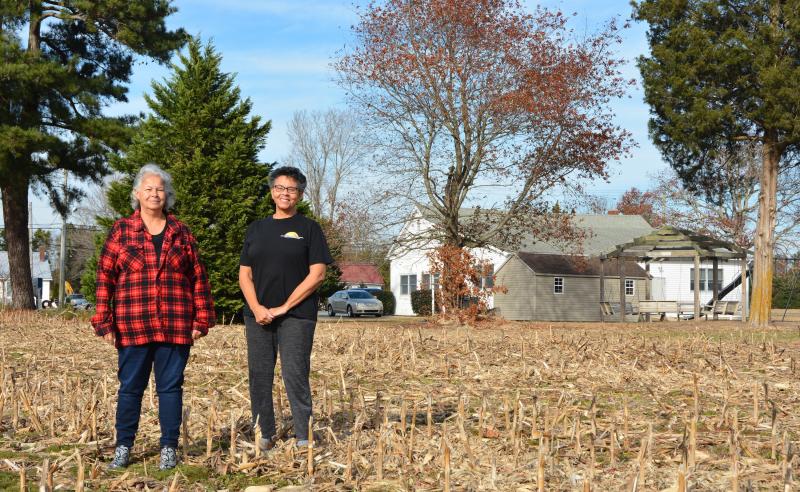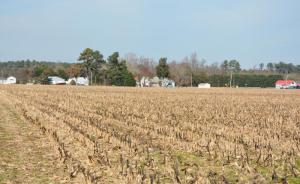Nanticoke Indians gifted 30 acres of ancestral lands
Similar to Indigenous people across the country, Millsboro’s Nanticoke Indians believe in the concept of living and working now to the benefit of tribal members seven generations into the future. With the recent donation of 30 acres of ancestral land, future generations of the Nanticoke Indian Association will look back at 2021 as a year that tribal elders did in fact work toward that common goal.
The donated acreage has an address of Rosdale Road. It’s a triangular shape that stretches from immediately behind the NIA Tribal Center off Route 24 to the western tree line of Warwick Park to the east. There’s a small portion of land that sits across the street, near the intersection with Gull Point Road. According to Sussex County property records, the land was sold in late October for approximately $990,000.
Nanticoke Indian Chief Natosha Carmine, the tribe’s first woman chief, was the driving force behind the land donation and quick to point out the Nanticokes didn’t put one dollar toward the land. She said she wanted to try and get the parcel because it will help build a strong community among tribal members.
There’s always been a vision for the tribe to have a safe place to commune and be a part of a larger group, said Carmine. There are thoughts of putting in a walking path, a large pavilion and some athletic fields, she said.
“It’s a vision that will be defined in the future,” said Carmine.
Former Nanticoke Tribal Council member Bonnie Hall happened to be at the tribal center during the interview with Carmine. The donation is personal for her, she said – she can recall playing on that same field as a child, because it was once owned by her aunt Madge Harmon and uncle Wilbur Harmon.
“There’s so many things that can be done with land,” said Hall. “It’s something to be very excited about.”
Carmine said over the years, before the land was put up for sale, the Harmons passed the land along to their children, then to the grandchildrens’ generation. They’re happy to see the association find a way to purchase the land because they’re not interested in having it developed, she said.
The Conservation Fund, a national conservation organization, worked with the tribe to facilitate the donation. The organization announced the land donation Nov. 16. Carmine said she was grateful for the Conservation Fund’s hard work.
“To be able to have solid ground to see and walk on makes a huge difference to the tribe,” said Carmine.
The land purchase wouldn’t have been possible without help from the Delaware Department of Natural Resources and Environmental Control’s Open Space Program, which approved spending $325,000 toward the land cost. The program’s administrative board recommended the amount of money during a meeting in June; DNREC Secretary Shawn Garvin approved it shortly afterward.
In an email Dec. 3, Nikki Lavoie, DNREC spokesperson, said this project is the latest example of the successful efforts of the Open Space Program, which has helped preserve land in all three counties to support habitat and for people to enjoy. This important work between state government and conservation groups preserves and protects Delaware’s diverse natural and cultural heritage, she said.
The land purchase would also not have been possible without a grant from the Mt. Cuba Center, a Hockessin-based botanical garden that since 2005 has also helped preserve natural habitats across the state.
Mt. Cuba Executive Director Jeff Downing said the center was enthusiastic about helping facilitate the transaction, and that the preservation of this land in Millsboro fits well into its land conservation mission. The Nanticoke Indians have been cultivating that land for thousands of years, so they are among the wisest and most knowledgeable people about how to best preserve it, he said.
Mt. Cuba’s goal is to conserve ecologically vulnerable land and ecosystems into perpetuity, said Downing, adding the center parcel can now be added to the conservation program’s other 14,000 acres of saved open space.
“The value of this land was obvious,” said Downing.
Moving forward, the state’s Division of Historical and Cultural Affairs will hold the conservation easement on the land. Tim Slavin, division director, said he’s fascinated with the vision the Nanticokes have for the land, and the division is happy to facilitate that vision coming to fruition.
The future for the Nanticoke Indians looks bright. In addition to the land donation, the tribe secured more than $1.3 million in the state’s Bond Bill this year to help renovate and update the tribal center. The center was recently recognized as historically significant by the state because of its history as the tribe’s school for 40 years in the early 1900s.
The use has changed from being a school, but structurally not much has changed with the building, said Carmine. There’s only one large meeting room right now, which means there can only be one tribal organization meeting at once. The plan is to add two more rooms and update the restrooms, she said.
Carmine said there will be an official blessing of the land and groundbreaking ceremony in the future.
Chris Flood has been working for the Cape Gazette since early 2014. He currently covers Rehoboth Beach and Henlopen Acres, but has also covered Dewey Beach and the state government. He covers environmental stories, business stories and random stories on subjects he finds interesting, and he also writes a column called Choppin’ Wood that runs every other week. He’s a graduate of the University of Maine and the Landing School of Boat Building & Design.






















































